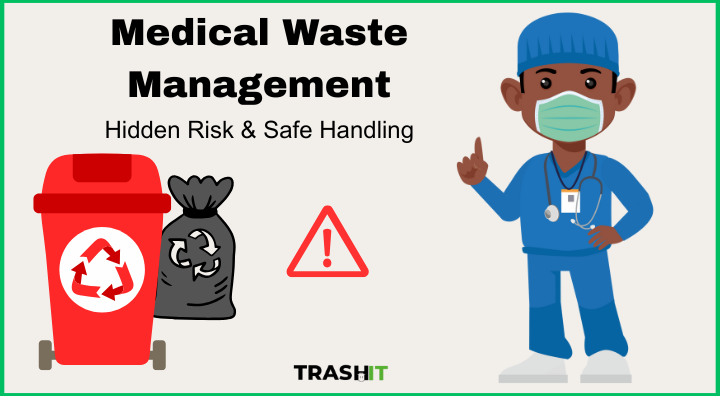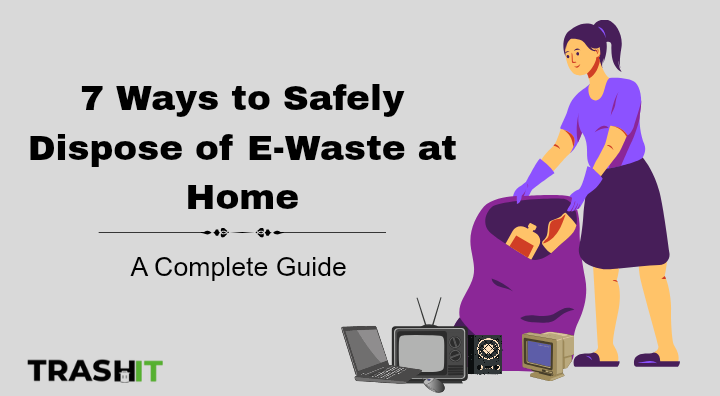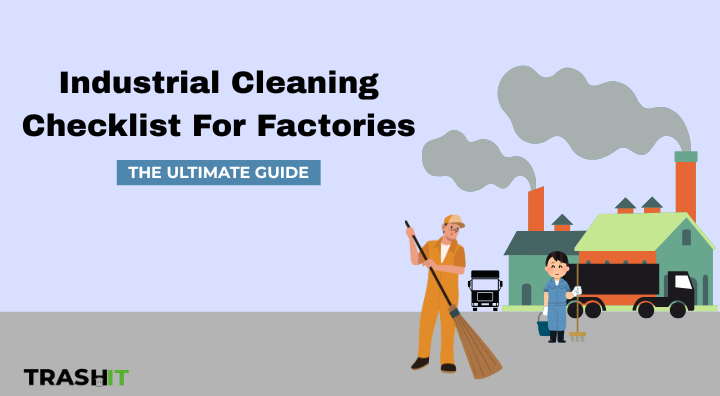
In today’s article, you and I will discuss more about medical waste management. But the question right now is…, What are the hidden risks and how can you manage them?
This article was written for educational purposes to help healthcare professionals, facility managers, and caregivers understand the importance of safe medical waste management. While I’m not a medical practitioner, the information shared here is based on authoritative sources, including the World Health Organization (WHO), Centers for Disease Control and Prevention (CDC), Occupational Safety and Health Administration (OSHA), and the U.S. Environmental Protection Agency (EPA).
Every day, hospitals, clinics, dental offices, and even homes generate millions of pounds of medical waste from used syringes and blood-stained bandages to expired drugs and contaminated gloves.
According to a report from the World Health Organization (WHO), it estimates that 15% of healthcare waste is hazardous, potentially infectious, toxic, or radioactive.
But let me ask you this…, have you ever stopped to wonder what happens to that waste once it leaves the clinic or hospital?
And why does it matter to you, whether you’re a healthcare professional, facility manager, or even a home caregiver?
Well, the truth is that…, medical waste doesn’t just disappear.
If it is handled improperly, it can harm healthcare workers, contaminate communities, and pollute the environment.
The reason for this article guide is to help you understand the hidden risks of medical waste, and walk you through on how to manage it safely and responsibly.
I will want you to pay attention to how you read this article.
Keep reading…
What Exactly Is Medical Waste?
Also known as regulated medical waste (RMW) or biohazardous waste.
Medical waste refers to any material generated during the diagnosis, treatment, or immunization of humans or animals that poses a risk of infection or contamination.
If you look at this resource article from EPA – Medical Waste Basics, it defined medical waste as…
“Medical waste is a subset of wastes generated at health care facilities, such as hospitals, physicians’ offices, dental practices, blood banks, and veterinary hospitals/clinics, as well as medical research facilities and laboratories.”
It also said…, “Generally, medical waste is healthcare waste that may be contaminated by blood, body fluids or other potentially infectious materials and is often referred to as regulated medical waste.”
Types of Medical Waste
Understanding the type of medical waste and how it is categorized is the first step to managing them safely.
Below are the main types, with examples you’ll recognize:
1; Infectious Waste
Any waste contaminated with blood, bodily fluids, or other potentially infectious materials.
Examples: Used bandages, swabs, surgical dressings, culture dishes, and disposable gowns.
2; Pathological Waste
Human or animal tissues, organs, or body parts removed during surgery or autopsy.
Examples: Biopsy samples, amputated limbs, and anatomical specimens.
3; Sharps
Objects capable of puncturing or cutting the skin. These are among the most dangerous types of medical waste due to injury and infection risks.
Examples: Needles, syringes, scalpels, blades, and broken glass.
For more information about sharp safety, you can check at sharps safety program resource. It is a Workbook to help healthcare facilities prevent needlesticks and other sharps-related injuries to healthcare personnel.
4; Chemical Waste
Substances used in cleaning, disinfecting, or laboratory testing that can be toxic or corrosive.
Examples: Solvents, disinfectants, and heavy metals like mercury from thermometers or batteries.
5; Pharmaceutical Waste
Expired, unused, or contaminated medications and vaccines.
Examples: Expired antibiotics, chemotherapy drugs, and partially used medication vials.
6; Genotoxic & Radioactive Waste
Highly specialized waste requiring strict control.
Examples: Cytotoxic drugs used in cancer treatment, and radioactive materials from nuclear medicine or radiology departments.
The Hidden Risks of Medical Waste
When medical waste becomes silent, what I mean is that, if it is improperly handled or disposed of, it can potentially become a threat to…
- Public health
- Workers
- The environment
Let’s break down the main risks.
1. Public Health Risks
Improper medical waste disposal can create breeding grounds for pathogens and antibiotic-resistant bacteria.
Some of the major risks include:
- Disease Transmission: Used syringes and contaminated waste can spread HIV, Hepatitis B, and Hepatitis C.
- Community Outbreaks: In areas where waste is dumped illegally or burned in open air, communities face increased exposure to infections and toxins.
- Antimicrobial Resistance (AMR): The misuse and poor disposal of antibiotics contribute to superbugs that are harder to treat.
2. Environmental Risks
When medical waste ends up in landfills or waterways, it can wreak long-term environmental damage which are:
- Water Contamination: Leaching chemicals and pharmaceuticals can enter groundwater and rivers, affecting drinking water and aquatic life.
- Soil Pollution: Hazardous substances alter soil composition, harming agriculture and ecosystems.
- Air Pollution: Incinerating waste without proper emissions control releases dioxins, furans, and other carcinogenic compounds into the atmosphere.
3. Occupational Risks
Healthcare and sanitation workers are on the front lines of medical waste exposure.
Here are some common risks include:
- Needlesticks Injuries: Accidental punctures from improperly discarded sharps.
- Exposure to Pathogens: Contact with infectious materials during handling or transport.
- Chemical Burns or Inhalation Hazards: Especially during cleaning, sterilization, or waste treatment.
4. Legal & Financial Risks
Regulations on medical waste disposal are stringent for a reason.
Like the noncompliance can result in hefty fines, lawsuits, and reputational damage.
Key regulatory bodies include:
- OSHA (Occupational Safety and Health Administration) – Enforces worker safety around bloodborne pathogens.
- EPA (Environmental Protection Agency) – Oversees waste treatment and disposal standards.
- DOT (Department of Transportation) – Regulates the transportation of hazardous materials.
In short, ignoring medical waste management isn’t just dangerous, it’s expensive.
How to Manage Medical Waste Safely: A Step-by-Step Guide
Effective medical waste management relies on five foundational pillars, which is from segregation to final disposal.
Here’s how to build a compliant, safe, and sustainable system.
Step 1: Segregation & Categorization

The golden rule: “Segregate at the source”
That means waste must be separated where it’s generated not later in storage or transport.
Use a color-coded system to distinguish waste types clearly:
| Color Code | Type of Waste | Examples |
|---|---|---|
| Red | Infectious waste | Blood-soaked bandages, swabs, surgical dressings |
| Yellow | Chemical and pharmaceutical waste | Disinfectants, expired medicines |
| Blue/White (translucent) | Sharps | Needles, syringes, blades |
| Black | General non-hazardous waste | Paper, packaging materials, food waste |
Best Practices:
- Train all staff on the color-coding system.
- Never mix hazardous and non-hazardous waste.
- Clearly label bins with biohazard symbols.
💡 Tip: Place segregation bins as close as possible to the point of waste generation (e.g., operating rooms, patient care areas, labs).
Step 2: Safe Handling & Storage
Once segregated, waste must be handled safely to prevent exposure.
Here are key guidelines:
- Use Personal Protective Equipment (PPE): Gloves, masks, goggles, and gowns are mandatory.
- Sharps Safety: Always dispose of needles directly into a puncture-proof sharps container.
- Limit Storage Time: Infectious waste should not be stored beyond 48 hours in warm climates.
- Secure Storage Area: Ensure waste storage areas are locked, ventilated, and pest-free.
Step 3: Proper Containers & Labeling
Selecting the right container reduces the risk of leaks, spills, and cross-contamination.
Below are container requirements:
- Leak-proof, tear-resistant bags for soft waste (infectious, pathological).
- Rigid, puncture-proof containers for sharps.
- Clearly labeled with the international biohazard symbol, waste type, and generation date.
Each container should also include:
- Facility name and location
- Contents identification
- Handling precautions
🚫 Never overfill containers. Fill sharps bins only up to three-quarters full before sealing.
Step 4: Choosing the Right Disposal or Treatment Method
Different types of waste require different treatment and disposal methods. Here are the main ones:
| Method | Use Case | Pros | Cons |
|---|---|---|---|
| Incineration | Pathological, chemical waste | Destroys pathogens | Emits pollutants if uncontrolled |
| Autoclaving | Infectious waste, sharps | Cost-effective, safe | Not for chemical/pharma waste |
| Chemical Disinfection | Liquid waste | Fast, simple | Residual chemical risk |
| Microwaving/Irradiation | General sterilization | Low emissions | High equipment cost |
♻️ Where possible, combine methods to balance safety, cost, and environmental impact.
Step 5: Transportation & Documentation
Waste transport must comply with local and federal regulations. Let’s look at the local and federal regulations practices…
Best Practices:
- Use licensed medical waste transporters.
- Vehicles must be leak-proof and easy to disinfect.
- Maintain manifests and tracking forms for every waste shipment.
- Keep records for at least three years to ensure regulatory compliance.
📋 Pro Tip: Regularly audit your transporter’s certifications and permits to avoid liability for improper handling downstream.
Best Practices for Different Healthcare Settings

Each healthcare setting has unique waste challenges. Here’s how to tailor your approach:
For Large Hospitals
- Develop a comprehensive waste management plan with clear SOPs (Standard Operating Procedures).
- Assign dedicated Environmental Health & Safety (EHS) officers or teams.
- Use digital tracking systems for waste generation and disposal.
- Conduct annual staff training and refresher courses.
Small Clinics & Private Practices
- Partner with a certified medical waste disposal company for regular pickups.
- Use compact autoclaves or sharps mail-back programs to reduce costs.
- Maintain a waste segregation chart in visible areas for staff reference.
- Document all disposal activities for compliance audits.
Dental Offices & Veterinarians
- Focus on sharps and amalgam waste management.
- Use amalgam separators to prevent mercury contamination in wastewater.
- Ensure animal tissues and biological waste are disposed of through regulated channels.
Home Healthcare & Patients
Home-generated medical waste also poses risks if mishandled.
Sharps Disposal:
- Use FDA-cleared sharps containers.
- Never throw needles in household trash or recycling bins.
- If unavailable, use a heavy-duty plastic bottle (like a detergent bottle) as a temporary container.
Medication Disposal:
- Participate in Drug Take-Back Programs or use authorized drop boxes at pharmacies.
- Never flush medications down the toilet unless specifically instructed by the label.
Myth vs. Fact: Common Misconceptions About Medical Waste
| Myth | Facts |
|---|---|
| “All medical waste is infectious.” | Only about 15% is hazardous. |
| “Incineration is the best method for all waste.” | Each type requires specific treatment. |
| “Mixing waste types saves money.” | It increases risk and legal penalties. |
| “Small clinics are exempt from rules.” | All healthcare facilities must comply. |
Checklist: Medical Waste Management Audit
You can use this checklist to evaluate your facility’s waste practices:
- Are waste bins color-coded and clearly labeled?
- Are staff trained in waste segregation and PPE use?
- Are sharps containers puncture-proof and replaced regularly?
- Are waste storage areas secure and ventilated?
- Do you maintain manifests for all waste transported off-site?
- Do you partner only with licensed waste disposal providers?
- Are you compliant with OSHA, EPA, and local regulations?
About This Guide:
This educational resource was created to raise awareness about the risks associated with improper medical waste disposal and to outline evidence-based best practices. The content draws from publicly available resources from the CDC, EPA, OSHA, and WHO to ensure accuracy and compliance with current standards
Conclusion
Safe medical waste management is not just a compliance requirement, it’s a moral responsibility
Every syringe, glove, and vial has the potential to impact human lives and the environment if mishandled.
If you’re running a hospital, small clinic, veterinary practice, or providing home care, always remember that you play a role in breaking the chain of contamination.
Audit your current practices. Train your staff. Partner with reputable waste disposal professionals like TrashIt Integrated Services – Waste Management And Recycling.
Together, we can turn medical waste from a hidden hazard into a model of safety and sustainability.


